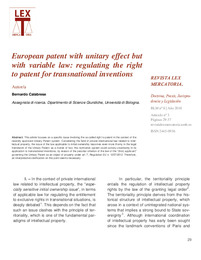Please use this identifier to cite or link to this item:
https://hdl.handle.net/11000/26717Full metadata record
| DC Field | Value | Language |
|---|---|---|
| dc.contributor.author | Calabrese, Bernardo | - |
| dc.date.accessioned | 2022-05-02T07:42:15Z | - |
| dc.date.available | 2022-05-02T07:42:15Z | - |
| dc.date.created | 2018-05-08 | - |
| dc.identifier.citation | nº8 (2018) | es_ES |
| dc.identifier.issn | 2445-0936 | - |
| dc.identifier.uri | http://hdl.handle.net/11000/26717 | - |
| dc.description.abstract | This article focuses on a specific issue involving the so called right to patent in the context of the recently approved Unitary Patent system. Considering the field of private international law related to intel-lectual property, the issue of the law applicable to initial ownership becomes even more thorny in the legal framework of the Unitary Patent: as a matter of fact, this normative system could convey uncertainty in its application to transnational inventions, by reason of the peculiar criterion of the law of the “(first) applicant” governing the Unitary Patent as an object of property under art. 7, Regulation EU n. 1257/2012. Therefore, an interpretative clarification on this point seems necessary. | es_ES |
| dc.format | application/pdf | es_ES |
| dc.format.extent | 9 | es_ES |
| dc.language.iso | eng | es_ES |
| dc.publisher | Universidad Miguel Hernández de Elche | es_ES |
| dc.rights | info:eu-repo/semantics/openAccess | es_ES |
| dc.rights | Attribution-NonCommercial-NoDerivatives 4.0 Internacional | * |
| dc.rights.uri | http://creativecommons.org/licenses/by-nc-nd/4.0/ | * |
| dc.subject.other | 34 - Derecho::340 - Cuestiones generales de derecho. Métodos y ciencias auxiliares del derecho | es_ES |
| dc.title | European patent with unitary effect but with variable law: regulating the right to patent for transnational inventions | es_ES |
| dc.type | info:eu-repo/semantics/article | es_ES |
| dc.identifier.doi | 10.21134/lex.vi.565 | - |
| dc.relation.publisherversion | https://doi.org/10.21134/lex.vi.565 | - |

View/Open:
565-Texto del artículo-2582-1-10-20200713.pdf
128,55 kB
Adobe PDF
Share:
.png)
